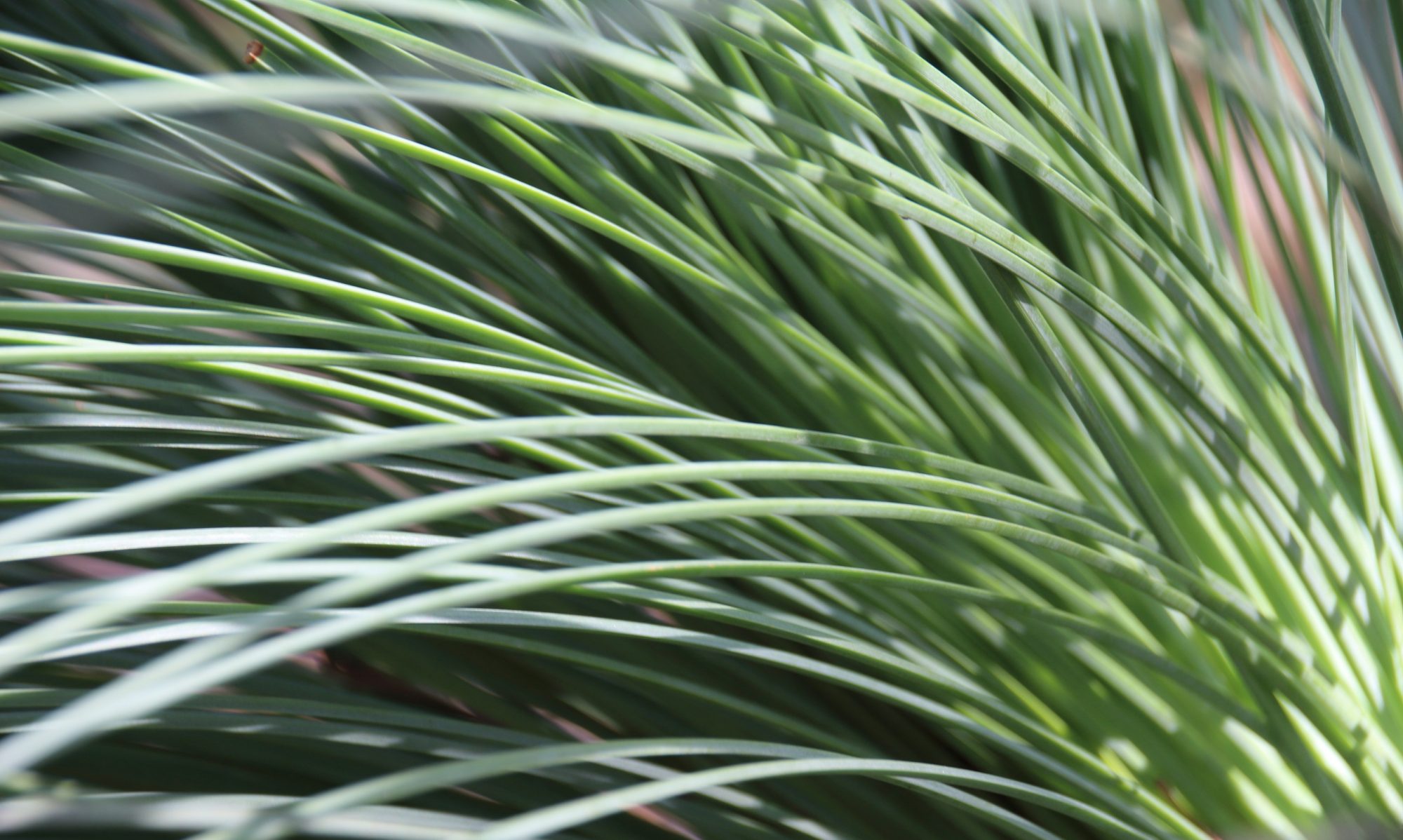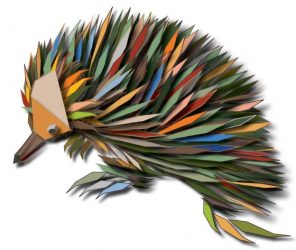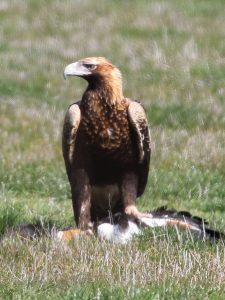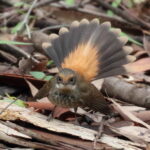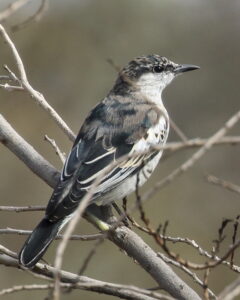Here is a list of Birds of Woowookarung and the Canadian Corridor, a work in progress by Joel Ellis and Rob Loveband. All photos by Rob unless otherwise acknowledged. Click on the small photo for an enlarged version. Click on the name for more information from Bird Life Australia and eBird Australia
Native Birds / Status / Notes
|
|
|
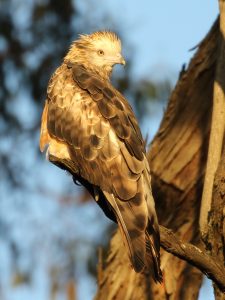 Square-tailed Kite Square-tailed KiteConfirmed in Woowookarung RP. Photographed in Mount Clear area of Park. Otherwise uncommon in Ballarat (with the exception of some semi-regular records at Midlands Golf Course). Distinct pale face sets it apart from any other bird of prey with reddish tones. Glides gracefully, low to the treetops, picking off unsuspecting birds and raiding nests. |
|
Black Kite |
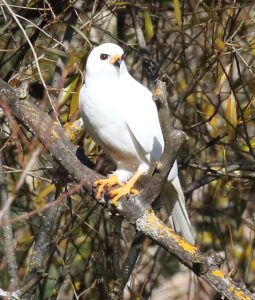 Grey Goshawk (White morph) Confirmed in Woowookarung RP. Also somewhat regularly seen at the nearby Mt Xavier Golf Course. Recently observed by Grant, perched some 10m from a Powerful Owl day roost on the outskirts of the Park. The species is known for its cunning habit of infiltrating flocks of cockatoos to stealthily ambush other prey (the way to spot the goshawk amongst a flying mass of cockies is in its longer tail and shorter neck). Surveys for prey from a concealed perch, often within gullies. Photo taken at Yuilles Wetlands by Rob in May 2020. Grey Goshawk (White morph) Confirmed in Woowookarung RP. Also somewhat regularly seen at the nearby Mt Xavier Golf Course. Recently observed by Grant, perched some 10m from a Powerful Owl day roost on the outskirts of the Park. The species is known for its cunning habit of infiltrating flocks of cockatoos to stealthily ambush other prey (the way to spot the goshawk amongst a flying mass of cockies is in its longer tail and shorter neck). Surveys for prey from a concealed perch, often within gullies. Photo taken at Yuilles Wetlands by Rob in May 2020. |
Collared Sparrowhawk 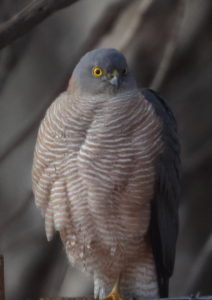 Likely an occasional presence at Woowookarung RP. A breeding pair has occupied the nearby Union Jack Reserve during breeding season (spring-summer, after which the sparrowhawks and goshawks tend to disperse into suburban neighbourhoods). Hunts birds, with a stealth ambush from a concealed perch. Likely an occasional presence at Woowookarung RP. A breeding pair has occupied the nearby Union Jack Reserve during breeding season (spring-summer, after which the sparrowhawks and goshawks tend to disperse into suburban neighbourhoods). Hunts birds, with a stealth ambush from a concealed perch. |
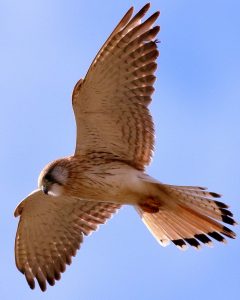 Nankeen Kestrel Nankeen KestrelConfirmed at Woowookarung RP. Observed on numerous occasions soaring over cleared ex-plantations. One of the smallest birds of prey; a falcon with slender build, often soaring on scythe-like wings. One of two Aussie birds on prey that can hover on the spot (the other is the white and silver Black-shouldered Kite which can be found at Mt Xavier and Midlands Golf Courses, but otherwise is mostly associated with pastureland either side of the Corridor), with rapid shallow wing beats. Ginger upperparts and beige underparts. |
Powerful Owl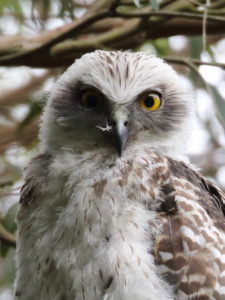 Confirmed at Woowookarung RP. Sightings in the south of Woowookarung RP, and also south of Mt Buninyong. Anecdotal trace evidence and vocal records by Grant at Union Jack Reserve and Mt Buninyong. At their size (65cm) and as a hollow-nester, very old and large Eucalyptus are vitally important and warrant preservation. Also not averse to roosting in pines. ‘Threatened’ in Victoria. Precise locations and landholder details are to be a closely guarded secret, to protect our Powerful Owls from wildlife crime. |
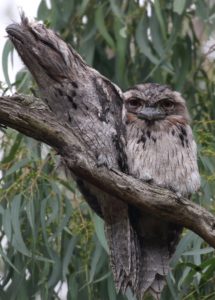 Tawny Frogmouth Tawny FrogmouthConfirmed within Woowookarung RP. Anecdotal report of frogmouths using a Fussell St backyard as a day roost, ditto Timbertop Dr (Mt Helen), Lake Esmond, and suburban Buninyong. Sighted in central Woowookarung forest off Katy Ryans Rd in 2019. This photo from 8/1/22 in Greenhaven estate, spotted by Paul in his back yard. Not to be mistaken as owls, as frogmouths are in a family of their own; frogmouths differ from owls in their weaker feet which means that they seize prey with their mouth rather their feet like owls, their camouflage and no need for nest-hollows, and their lack of facial disk/mask seen in owls. |
 Yellow-tailed Black-cockatoo Yellow-tailed Black-cockatooConfirmed in Woowookarung RP. Flyover flocks likely to be observed during flyovers, potentially with some stopovers in pines. Photographed in the Park by Rob. Population not suffering as much as other Black-Cockatoos species interstate, but needs to be monitored, as food trees decline. |
 Sulphur-crested Cockatoo Sulphur-crested CockatooConfirmed in Woowookarung RP. Common and widespread throughout the Corridor. |
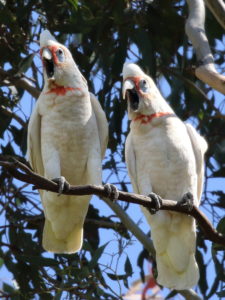 Long-billed Corella Long-billed CorellaConfirmed in Woowookarung RP. Common and widespread throughout the Corridor. The predominate corella species in the Ballarat area, with the other being Little Corella which is less common and widespread, despite occasional visitation by large nomadic flocks. The way to distinguish between the two (when detail in the bill cannot be discerned) is that Long-billed Corella has a smattering of salmon/scarlet around the throat and between the eyes and base of the bill, while Little Corella often shows a raised conical crest (which Long-billed lacks). |
 Galah GalahConfirmed in Woowookarung RP. Common and widespread throughout the Corridor. Seen daily in park near East Ballarat. |
 Crimson Rosella Crimson RosellaConfirmed in Woowookarung RP. Common and widespread throughout the Corridor. |
 Eastern Rosella: An occasional visitor to Rob’s backyard in Mt Clear area of Woowookarung RP. In Joel’s experience this shyer of the two rosellas tends to be reliably observed on golf courses, but otherwise is somewhat uncommon outside of Lake Wendouree. Eastern Rosella: An occasional visitor to Rob’s backyard in Mt Clear area of Woowookarung RP. In Joel’s experience this shyer of the two rosellas tends to be reliably observed on golf courses, but otherwise is somewhat uncommon outside of Lake Wendouree. |
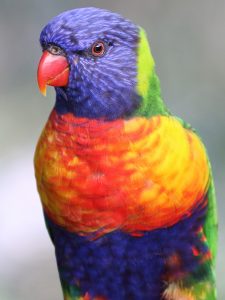 Rainbow Lorikeet Rainbow LorikeetConfirmed in Woowookarung RP. Common and widespread throughout the Corridor. |
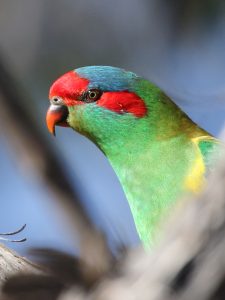 Musk Lorikeet Musk LorikeetConfirmed at Woowookarung RP. Potential visitor to the Park’s eucalypts when in flower. Sighted in Mt Clear by Rob. Nomadic bird that wanders (as opposed to migrates) to wherever the Eucalypts are in flower. |
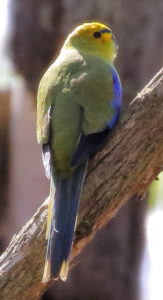 Blue-winged Parrot: Seen regularly in spring and summer, this small parrot is blue green in colour and quite difficult to see against the eucalypts. A thin blue line between the eyes is an identifying feature. Also seen on the Dementia Trail in Oct 21. Blue-winged Parrot: Seen regularly in spring and summer, this small parrot is blue green in colour and quite difficult to see against the eucalypts. A thin blue line between the eyes is an identifying feature. Also seen on the Dementia Trail in Oct 21. |

King Parrot: New to the region but seen with increasing frequency, this large parrot seems to be naturalising in Ballarat |
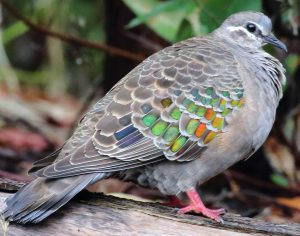 Common Bronzewing Common BronzewingConfirmed in Woowookarung RP. Common and widespread throughout the Corridor. |
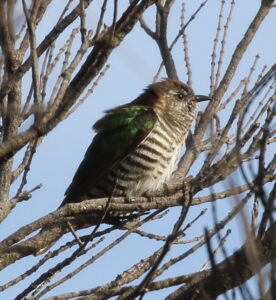 Shining Bronze-cuckoo Shining Bronze-cuckooPossibly at Woowookarung RP. Recorded by Joel in Union Jack Reserve, and it would not be a stretch of the imagination to suggest they could occur in Woowookarung RP. Spring-summer breeding migrant. Pretty iridescent green/bronze on upperparts and finely barred brown and white underparts, with barring that extends well up the face. Compared to Horsfield’s, Shining Bronze-cuckoo is more inclined towards woodlands and forests. |
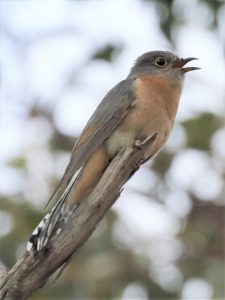 Fan-tailed Cuckoo Fan-tailed CuckooConfirmed at Woowookarung RP. Sighted along the 10,000 Step Nature Trail, and heard near the Scenic Lookout. Also occurs at Union Jack Reserve. Spring-summer breeding migrant that spends winters in northern Australia and PNG. |
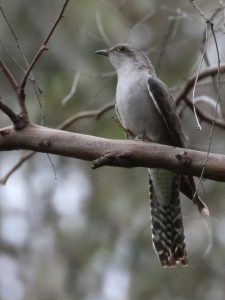 Pallid Cuckoo Pallid CuckooConfirmed at Woowookarung RP (as per photograph by Rob). Spring-summer breeding migrant that spends winters in northern Australia and PNG. |
 Laughing Kookaburra Laughing KookaburraConfirmed at Woowookarung RP. Consensus that Kookaburras are in decline in urban areas, but otherwise faring well in bushland and rural areas. |
 Sacred Kingfisher Sacred KingfisherLikely. Spring-summer breeding migrant that has been observed to both the north and south of Woowookarung RP, including Union Jack Reserve, Buninyong Bushland Reserve, and Ditchfield Reserve (north of Woowookarung RP). Not necessarily associated with water and fish, despite its name. |
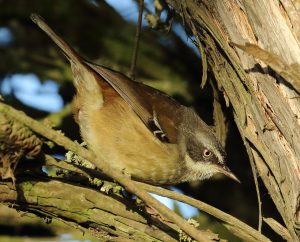 White-browed Scrubwren White-browed ScrubwrenConfirmed in Woowookarung. In decline, but relatively common locally, provided an understorey is present. |
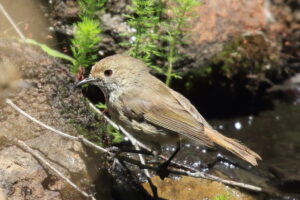 Brown Thornbill Brown ThornbillConfirmed in Woowookarung RP. Common and widespread throughout the Corridor. |
 Striated Thornbill Striated ThornbillConfirmed in Woowookarung RP. Common and widespread throughout the Corridor. |
 Spotted Pardalote Spotted PardaloteConfirmed at Woowookarung RP. Pardalote, observed by FoCC Committee, retreating into hole in earth embankment out the front of 55 Recreation Rd. |
 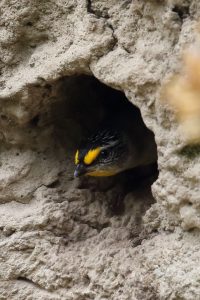 Striated Pardalote Striated PardaloteConfirmed at Woowookarung RP. Surprisingly no records from Woowookarung on eBird, but confirmed present by Rob. |
 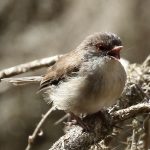 Superb Fairywren Superb FairywrenConfirmed in Woowookarung RP. Common and widespread throughout the Corridor. Left: male in breeding plumage. Right: female. |
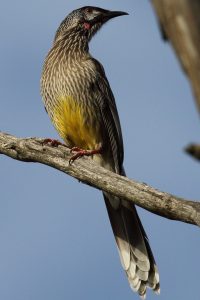 Red Wattlebird Red WattlebirdConfirmed in Woowookarung RP. Common and widespread throughout the Corridor. |
 White-eared Honeyeater White-eared HoneyeaterConfirmed in Woowookarung RP. Somewhat uncommon in most other Ballarat localities, but regularly sighted here, including a bird recently photographed here by Rob. Also Union Jack Reserve (Buninyong) and Mt Buninyong. A cheeky bird with the habit of plucking the fur off live wallabies and kangaroos, to use as nest material. |
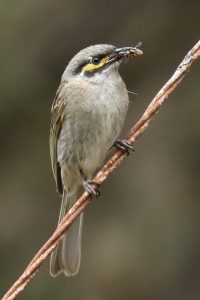 Yellow-faced Honeyeater Yellow-faced HoneyeaterConfirmed in Woowookarung RP, also relatively common and widespread throughout the Corridor. Part-migratory, whereby some of the local population remain all year round, while influxes of the species arrive over spring-summer. |
 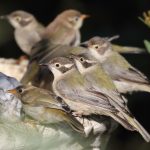 Brown-headed Honeyeater Brown-headed HoneyeaterConfirmed at Woowookarung RP. To date, eluded Joel’s detection, but sighted here with regularity by Rob. Second photo 3/3/20 in garden Mt Clear. Among the smallest honeyeaters. |
 White-naped Honeyeater White-naped HoneyeaterConfirmed in Woowookarung RP, also somewhat common and widespread throughout the Corridor. Similar migration habit as Yellow-faced Honeyeater, with the two species often intermingling. Seen 16/9/20 behind the rifle range. |
 New Holland Honeyeater New Holland HoneyeaterConfirmed in Woowookarung RP. Common and widespread throughout the Corridor. Seemingly a more conspicuous presence throughout Ballarat than in years past. Local population must be thriving. |
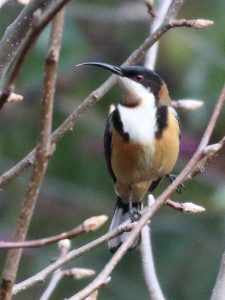 Eastern Spinebill Eastern SpinebillConfirmed in Woowookarung RP. Common and widespread throughout the Corridor. Associated with mid-storey flowering shrubs, but also a presence in eucalypt forests when gums are in flower. Daily visitor to gardens adjacent to park. |
 Varied Sittella Varied SittellaConfirmed in Woowookarung RP. Similar in behaviour to the White-throated Treecreeper, but where the treecreeper creeps up trees, the sittella scurries down them. |
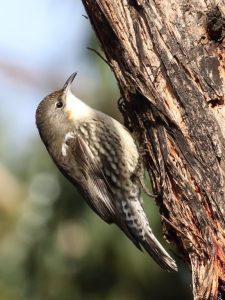 White-throated Treecreeper White-throated TreecreeperConfirmed in Woowookarung RP, and other eucalypt forest reserves. The species by nature, needs uninterrupted tree cover, as it is averse to ‘running (or flying) the gauntlet’ when trees are distanced too far apart. |
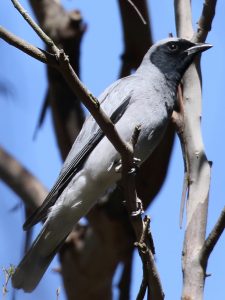 Black-faced Cuckooshrike Black-faced CuckooshrikeConfirmed at Woowookarung RP. Observed by the FoCC committee flying over the Wooowookarung RP Scenic Lookout. Voice distinctive. Another species for which some or all of the local population may migrate to northern Australia and PNG over autumn/winter, and back again over spring-summer to breed down south. |
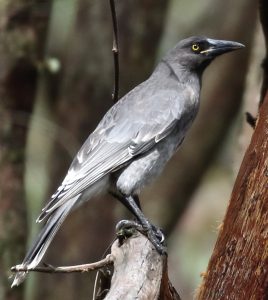 Grey Currawong Grey CurrawongConfirmed in Woowookarung RP. Common and widespread throughout the Corridor. |
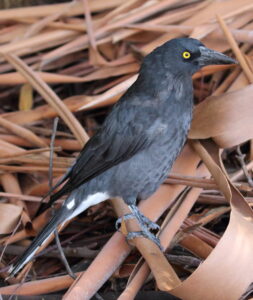 Pied Currawong Pied CurrawongLikely in Woowookarung RP. Common and widespread throughout the Corridor. Surprisingly, as yet no confirmed records in Woowookarung RP (eBird checklists pertaining to Woowookarung infrequently submitted), but it is common and abundant in Buninyong and southern Ballarat. Call sounds like its name (‘currawong-currawong-curr’) |
 Grey Butcherbird Grey ButcherbirdConfirmed in Woowookarung RP. Common and widespread throughout the Corridor. Older record on eBird, but photographed recently by Rob, and heard by Joel. |
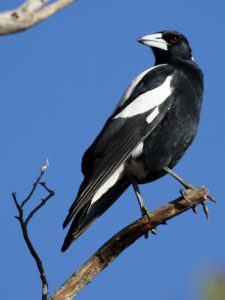 Australian Magpie Australian MagpieConfirmed in Woowookarung RP. Common and widespread throughout the Corridor. |
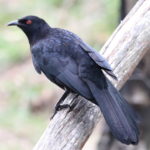 White-winged Chough White-winged ChoughConfirmed at Woowookarung RP, and also occurs at Union Jack Reserve and Buninyong Bushland. In the forests, forage on the ground in gregarious family units. White of wings often not apparent when wings are folded. Note the red eye and curved bill to distinguish it from the slightly larger Little Raven. |
Little Raven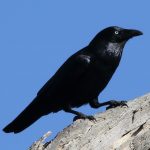 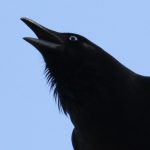 Confirmed in Woowookarung RP. Common and widespread throughout the Corridor. |
Satin Flycatcher  Confirmed in Woowookarung RP 2020 (Male photo.) Confirmed in Woowookarung RP 2020 (Male photo.)Summer breeding migrant that has been observed to both the north and south of Woowookarung, including Union Jack Reserve (Buninyong). Species in decline that favours intact wet forests. Pictured is a male (left) with glossy blue-black upperparts, while the female has the orange throat. |
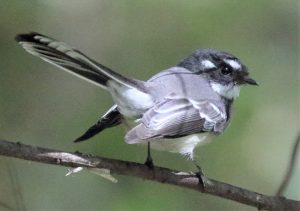 Grey Fantail Grey FantailConfirmed in Woowookarung RP, and also abounds at Union Jack Reserve and Buninyong Bushland Reserve. They’ll find you – very inquisitive, chirpy, flittering birds! Most or all of the local population may migrate north over winter, however. |
|
|
 Eastern Yellow Robin Eastern Yellow RobinConfirmed in Woowookarung, and other eucalypt forest reserves in the Corridor. Thriving throughout Ballarat more than other Robin species. Males and females are visually indistinguishable, which is breaking tradition for robins. |
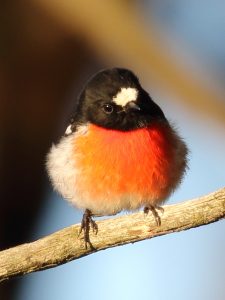 Scarlet Robin Scarlet RobinConfirmed in Woowookarung RP. In decline and not reported from many other Ballarat localities (notable exceptions include Union Jack Reserve, Mt Buninyong, and occasionally Buninyong Bushland Reserve). Many winter sightings in Woowookarung, and a visitor to Rob’s adjacent backyard. Pictured is a male, while the female has light brownish grey where the male is black, and the bright scarlet breast is a smaller patch coloured peach. If the red extends beyond the collar to the chin, it is the similar-looking but locally rarer Flame Robin (male). |
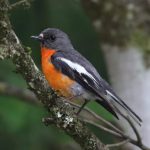
Flame Robin |
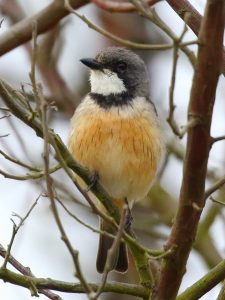 Rufous Whistler Rufous WhistlerConfirmed in Woowookarung RP. Spring-summer breeding migrant that spends winters in northern Australia and PNG. Pictured is an immature male moulting into adult plumage (adult males lose the breast streaks and have a more vibrant ginger colour). Females have a duller grey plumage. |
  Golden Whistler Golden WhistlerConfirmed in Woowookarung RP. Local migration between highland and lowland forest, with breeding in spring-summer. A photo of a male in Mount Clear in 2019, and female in April 2020 |
 Grey Shrikethrush Grey ShrikethrushConfirmed in Woowookarung RP. Common and widespread throughout the Corridor. |
 Mistletoebird MistletoebirdConfirmed in Woowookarung RP. Also seen by Joel at Fed Uni campus. Diet highly specialised to mistletoe fruit, which sees bird and plant closely tied together in a mutual symbiotic relationship; the birds rely on mistletoe for food, and the mistletoe relies on Mistletoebird to spread the seed through its faeces. Mistletoebirds will be wherever there is mistletoe. |
 Silvereye SilvereyeConfirmed at Woowookarung RP. Also Buninyong. |
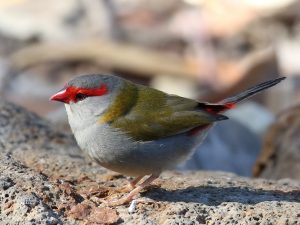 Red-browed Finch Red-browed FinchConfirmed at Woowookarung RP. Photographed here recently by Rob. Associated with understorey, often streamside. Only native finch in the Corridor (although Diamond Firetail may be found in outer north-west Ballarat). |
 White-faced Heron White-faced HeronConfirmed at Woowookarung RP, also somewhat common and widespread throughout our the Corridor. Frequents the water holes, garden ponds, and flooded roadside drainage lines around the Park. |
 Australian Wood Duck (Maned Duck) Australian Wood Duck (Maned Duck)Confirmed in Woowookarung RP. Common and widespread throughout the Corridor. Can be seen in wetlands edging the park. As a hollow-nester and grazer of lawns, it can be observed surprisingly far from wetlands, whether perched in Eucalypts or coming and going from the nest hollow. The Eucalypt forest at Woowookarung is not old enough for hollows to have formed, but large old trees are dotted throughout surrounding areas (Union Jack Reserve, Main Rd). |
 Little Pied Cormorant Little Pied CormorantConfirmed in Woowookarung RP. Common and widespread throughout the Corridor. In wetlands such as near Fed Uni. |
 Bassian Thrush Bassian ThrushConfirmed in the south of Woowookarung RP, as per recently reported by Grant. Otherwise very uncommon and infrequently recorded in Ballarat. One older record at Mt Buninyong. |
 Dusky Woodswallow Dusky WoodswallowConfirmed at Woowookarung RP. Photographed on the Dementia Trail 22/3/20. Otherwise uncommon in Ballarat, with the exception of Ditchfield Reserve (north of Woowookarung RP). Spring-summer breeding migrant that spends winters in northern Australia and PNG. Belongs to the same family as butcherbirds (including Australian Magpie) and currawongs, only much smaller; hence, not related to swallows, though their aerobatics to rival them. |
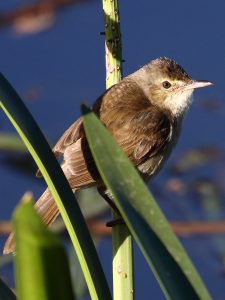 Australian Reed Warbler: Confirmed in the Corridor, where there are wetlands or dams lined with extensive reed (rush) cover. Another species for which some or all of the local population may migrate to northern Australia and PNG over autumn/winter, and back again over spring-summer to breed down south. Often heard rather than seen, as it sings persistently and noisily amongst the reeds where it forages and nests. A non-descript uniformly greyish brown bird, that to the untrained eye may resemble a thornbill, only slightly larger. Australian Reed Warbler: Confirmed in the Corridor, where there are wetlands or dams lined with extensive reed (rush) cover. Another species for which some or all of the local population may migrate to northern Australia and PNG over autumn/winter, and back again over spring-summer to breed down south. Often heard rather than seen, as it sings persistently and noisily amongst the reeds where it forages and nests. A non-descript uniformly greyish brown bird, that to the untrained eye may resemble a thornbill, only slightly larger. |
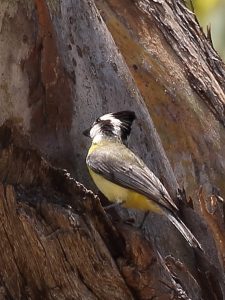 Eastern (Crested) Shrike-tit: Possible at Woowookarung RP and confirmed at Union Jack Reserve, and roadside gums along Main Rd Mt Helen. Favours large, old gums (often stream-side) that shed their bark — these conditions provide good forage substrate for insect prey. Both sexes have pretty yellow underparts (the male’s yellow is particularly vibrant, rivalling the male Golden Whistler). Distinguishing it from male Golden Whistler, is the Eastern Shriketit’s crest, thicker bill, and a black line running through the face. Eastern (Crested) Shrike-tit: Possible at Woowookarung RP and confirmed at Union Jack Reserve, and roadside gums along Main Rd Mt Helen. Favours large, old gums (often stream-side) that shed their bark — these conditions provide good forage substrate for insect prey. Both sexes have pretty yellow underparts (the male’s yellow is particularly vibrant, rivalling the male Golden Whistler). Distinguishing it from male Golden Whistler, is the Eastern Shriketit’s crest, thicker bill, and a black line running through the face. |
 Willie Wagtail: Confirmed at Lake Esmond, but not as yet at Woowookarung RP. Well-known bird that is widespread, but consensus is that it is not as commonly observed as it once was. Favours farmland, golf courses, and other open spaces lined with trees (often pines). Very vocal and full of character. Willie Wagtail: Confirmed at Lake Esmond, but not as yet at Woowookarung RP. Well-known bird that is widespread, but consensus is that it is not as commonly observed as it once was. Favours farmland, golf courses, and other open spaces lined with trees (often pines). Very vocal and full of character.
|
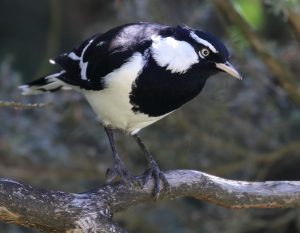 Magpie-lark: Also known as Mudlark and Pee-wee, this bird is common throughout much of Ballarat, including Fed Uni (Mt Helen campus) and Lake Esmond, but not as yet recorded at Woowookarung. Favours lightly wooded habitats. Males have a horizontal stripe through the eye, while females have a vertical stripe through the eye. Magpie-lark: Also known as Mudlark and Pee-wee, this bird is common throughout much of Ballarat, including Fed Uni (Mt Helen campus) and Lake Esmond, but not as yet recorded at Woowookarung. Favours lightly wooded habitats. Males have a horizontal stripe through the eye, while females have a vertical stripe through the eye. |
 White-plumed Honeyeater: No records as yet in Woowookarung RP, but given it has been a visitor to Joel’s not-such-a-bird-paradise backyard (Buninyong), it could plausibly turn up in more proper habitat within the Corridor, including Buninyong Golf Course, and potentially Woowookarung RP. Tones of light grey and olive-yellow, with a fine white eclipse either side of the neck. White-plumed Honeyeater: No records as yet in Woowookarung RP, but given it has been a visitor to Joel’s not-such-a-bird-paradise backyard (Buninyong), it could plausibly turn up in more proper habitat within the Corridor, including Buninyong Golf Course, and potentially Woowookarung RP. Tones of light grey and olive-yellow, with a fine white eclipse either side of the neck. |
 Welcome Swallow: Confirmed in Woowookarung RP (where the forest is fringed by paddocks). Another species for which some or all of the local population may migrate to northern Australia and PNG over autumn/winter, and back again over spring-summer to breed down south. Performs aerobatics in its restless flying back and forth for aerial insect prey. Small bird, with its deeply forked tail a diagnostic feature. Welcome Swallow: Confirmed in Woowookarung RP (where the forest is fringed by paddocks). Another species for which some or all of the local population may migrate to northern Australia and PNG over autumn/winter, and back again over spring-summer to breed down south. Performs aerobatics in its restless flying back and forth for aerial insect prey. Small bird, with its deeply forked tail a diagnostic feature. |
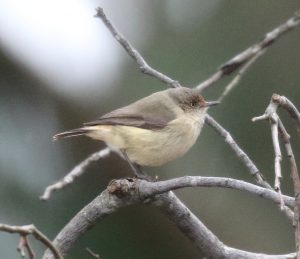 Buff-rumped Thornbill: Confirmed in the Corridor (Buninyong), possible in Woowookarung RP. Nondescript brown thornbill, with little pattern to speak of apart from ‘scalloping’ on the forehead and behind the eye. Buff-rumped Thornbill: Confirmed in the Corridor (Buninyong), possible in Woowookarung RP. Nondescript brown thornbill, with little pattern to speak of apart from ‘scalloping’ on the forehead and behind the eye. |
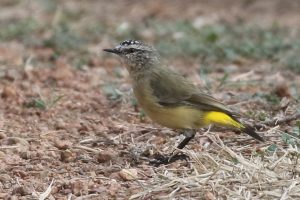 Yellow-rumped Thornbill: Confirmed in the Corridor (Union Jack Reserve, Buninyong Bushland Reserve), possible in Woowookarung RP. Forest on the fringe of farmland is suitable. Gregarious parties forage on the ground and lower storeys of vegetation. Yellow-rumped Thornbill: Confirmed in the Corridor (Union Jack Reserve, Buninyong Bushland Reserve), possible in Woowookarung RP. Forest on the fringe of farmland is suitable. Gregarious parties forage on the ground and lower storeys of vegetation. |
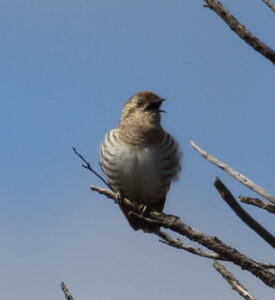 Horsfield’s Bronze-cuckoo: Vocal IDs by Joel in Buninyong. Suspect the open ex-plantation areas could make for suitable habitat. Similar appearance to Shining, but not as glossy, has a bold eye stripe, and the barring does not extend beyond the collar. Spring-summer breeding migrant. As with all other local cuckoos, it is a brood parasite (i.e. it lays its eggs in the nest of other species, leaving the incubating and feeding duties to the adoptive parents). Horsfield’s Bronze-cuckoo: Vocal IDs by Joel in Buninyong. Suspect the open ex-plantation areas could make for suitable habitat. Similar appearance to Shining, but not as glossy, has a bold eye stripe, and the barring does not extend beyond the collar. Spring-summer breeding migrant. As with all other local cuckoos, it is a brood parasite (i.e. it lays its eggs in the nest of other species, leaving the incubating and feeding duties to the adoptive parents). |
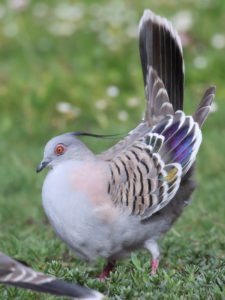 Crested Pigeon: Native pigeon confirmed at Lake Esmond and Buninyong, but as yet no records at Woowookarung RP. Crested Pigeon: Native pigeon confirmed at Lake Esmond and Buninyong, but as yet no records at Woowookarung RP. |
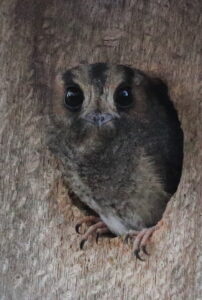 Australian Owlet-nightjar: Small avian fluffball that is rarely encountered due to its nocturnal habit and daytime shelter in tree hollows (they do however sun themselves at the entrance of its hollow). Nationally widespread yet (I suspect) little-known, and seldom recorded in Ballarat. Related to swifts. Signposts at Union Jack Reserve mention its residence in the reserve’s hollow-bearing large old gums. Also observed on a Grenville property near Enfield (the Corridors southern limit). Distinct call, worth referencing via online sound libraries and listening out for (for those locals living near bushland). Australian Owlet-nightjar: Small avian fluffball that is rarely encountered due to its nocturnal habit and daytime shelter in tree hollows (they do however sun themselves at the entrance of its hollow). Nationally widespread yet (I suspect) little-known, and seldom recorded in Ballarat. Related to swifts. Signposts at Union Jack Reserve mention its residence in the reserve’s hollow-bearing large old gums. Also observed on a Grenville property near Enfield (the Corridors southern limit). Distinct call, worth referencing via online sound libraries and listening out for (for those locals living near bushland). |
 Australian (Southern) Boobook: Common and widespread smallish owl. Another nocturnal birds whose sighting report frequency does not reflect its commonness. Vocal ID by Joel on Mt Xavier Golf Course, which given this location’s close proximity to Woowookarung RP, it could quite plausibly turn up in the Park. Closely related to Powerful Owl, but roughly half the size, has visibly weaker feet, splotches instead of the streaks, and a distinct white ‘X’ forming goggles. Unlike the rarer Powerful Owl, Australian Boobook has been known to roost in sheds/garages as well as a shady tree. One of many predatory species that needs to be protected from secondhand rodenticide poisoning. Need more data on the often-forgotten nocturnal species. |
| Australian Hobby: Confirmed in the Corridor. Specifically, a probable breeding pair suspected to be resident at the Buninyong Golf Course in recent years. Joel’s research found it to be (surprisingly) the most commonly recorded bird of prey at local golf courses (including those within the Corridor), but otherwise widely believed to be uncommon. Suspect that, among falcons, it has the greatest affinity with wooded habitats that are not strictly open and almost-treeless. Therefore, sightings at Woowookarung are considered plausible. Partial to the exposed perch of dead, leafless trees from which they survey the landscape for bird prey. Formerly known as Little Falcon, it has slate-grey upperparts, rufous orange streaked underparts, and black cheek patches. |
 Brown Falcon: Confirmed in the Corridor (Buninyong and Scotsburn), and in Woowookarung RP. Farmland on the fringes of bushland is good habitat. As with all falcons, Brown Falcons in flight don’t show the spread ‘fingers’ of eagles, kites and hawks, but this one is larger and thicker-set than other local falcons. Varied colour morphs including: ‘pale’, characterised by beige underparts and dark brown upperparts; ‘dark’ which is uniformly dark brown; and ‘rufous’, which has orange tones. Common among all colour morphs is a double ‘tear-drop’ on each eye, and brown half-length ‘trousers’. Brown Falcon: Confirmed in the Corridor (Buninyong and Scotsburn), and in Woowookarung RP. Farmland on the fringes of bushland is good habitat. As with all falcons, Brown Falcons in flight don’t show the spread ‘fingers’ of eagles, kites and hawks, but this one is larger and thicker-set than other local falcons. Varied colour morphs including: ‘pale’, characterised by beige underparts and dark brown upperparts; ‘dark’ which is uniformly dark brown; and ‘rufous’, which has orange tones. Common among all colour morphs is a double ‘tear-drop’ on each eye, and brown half-length ‘trousers’. |
 Brown Goshawk: Confirmed in the Corridor (Union Jack Reserve), likely in Woowookarung RP. Robust hawk that differs from the exceptionally similar-looking but smaller Collared Sparrowhawk in that the goshawk has a larger (squarer) head and bill, pronounced brow ridge (‘goshawks glare, sparrowhawks stare’), thicker legs, and a rounded (not squared and notched) tail. The Brown Goshawk’s middle toe is long, but not exceedingly long, like that of Collared Sparrowhawk. Hunts birds and the odd rabbit, with a stealth ambush from a concealed perched. Brown Goshawk: Confirmed in the Corridor (Union Jack Reserve), likely in Woowookarung RP. Robust hawk that differs from the exceptionally similar-looking but smaller Collared Sparrowhawk in that the goshawk has a larger (squarer) head and bill, pronounced brow ridge (‘goshawks glare, sparrowhawks stare’), thicker legs, and a rounded (not squared and notched) tail. The Brown Goshawk’s middle toe is long, but not exceedingly long, like that of Collared Sparrowhawk. Hunts birds and the odd rabbit, with a stealth ambush from a concealed perched. |
 Australasian (Purple) Swamphen: Similar habitat preference to Coot and Moorhen. Differs in its larger size, red head shield, and foraging habit of stalking the margins of waterbodies for all manner of critters. Australasian (Purple) Swamphen: Similar habitat preference to Coot and Moorhen. Differs in its larger size, red head shield, and foraging habit of stalking the margins of waterbodies for all manner of critters. |
 Dusky Moorhen: Similar to Eurasian Coot in habitat preference and appearance. Compared to the coot, Dusky Moorhen differs in its red and yellow bill, and fade purple tinge. Dusky Moorhen: Similar to Eurasian Coot in habitat preference and appearance. Compared to the coot, Dusky Moorhen differs in its red and yellow bill, and fade purple tinge. |
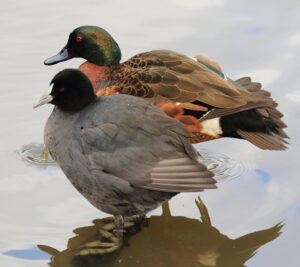 Eurasian Coot: Waterfowl common in permanent bodies of water of sufficient size, hence not a Woowookarung RP inhabitant, but able to be observed throughout the Corridor (Lake Esmond, Buninyong Botanic Gardens). Despite its name, it is native to Australia (widespread internationally, and long ago colonised Australia unassisted by humans). |
 Australian White Ibis: Common all throughout Ballarat but unconfirmed in Woowookarung RP. Maligned as a ‘Bin chicken’ and ‘Trash turkey’, but not all of its species fit the stereotype of rubbish scavengers. Australian White Ibis: Common all throughout Ballarat but unconfirmed in Woowookarung RP. Maligned as a ‘Bin chicken’ and ‘Trash turkey’, but not all of its species fit the stereotype of rubbish scavengers. |
 White-necked Heron: Confirmed in the Corridor (Navigators). Flooded paddocks and shallow dams suitable. Large than White-faced Heron, with extensive white and bluish dark grey plumage. White-necked Heron: Confirmed in the Corridor (Navigators). Flooded paddocks and shallow dams suitable. Large than White-faced Heron, with extensive white and bluish dark grey plumage. |
 Eastern Great Egret: Confirmed in the Corridor (The Gong Reserve, Buninyong Golf Course). Long-legged, kink-necked, all-white egret that favours shallows of wetlands, and flooded roadside drainage lines. Eastern Great Egret: Confirmed in the Corridor (The Gong Reserve, Buninyong Golf Course). Long-legged, kink-necked, all-white egret that favours shallows of wetlands, and flooded roadside drainage lines. |
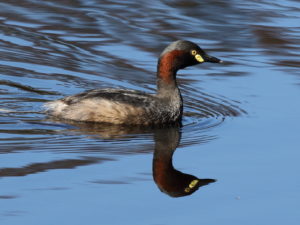 Australasian Grebe: Confirmed at The Gong Reserve (Buninyong Botanic Gardens). The untrained eye might confuse these small water-birds with ducklings, but the adult Australasian Grebe is just small. Poorly adapted to walking on land, grebes (not related to ducks) are virtually always either swimming or flying. Chicks may piggyback on parent’s back. The adults’ breeding plumage (sexes indistinguishable) has a pretty chestnut-coloured patch behind the cheek. Australasian Grebe: Confirmed at The Gong Reserve (Buninyong Botanic Gardens). The untrained eye might confuse these small water-birds with ducklings, but the adult Australasian Grebe is just small. Poorly adapted to walking on land, grebes (not related to ducks) are virtually always either swimming or flying. Chicks may piggyback on parent’s back. The adults’ breeding plumage (sexes indistinguishable) has a pretty chestnut-coloured patch behind the cheek. |
| Freckled Duck: Observed on rare occasions at The Gong Reserve (Buninyong Botanic Gardens). Very shy duck that is considered ‘Threatened’, and not often observed outside of Lake Wendouree. Has suffered from recreational duck-shooting. Scoop-like upturned bill (red at the base for the male), and a Donald Duck-esque tuft of sorts at the back of the head. |
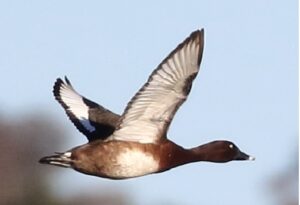 Hardhead: More selective of wetland habitat than other waterbirds, but confirmed in the Corridor (Buninyong Botanic Gardens, Lake Esmond, and once on Buninyong Golf Course). Dark brown duck formerly known as White-eyed Duck (as the male has a white eye). Hardhead: More selective of wetland habitat than other waterbirds, but confirmed in the Corridor (Buninyong Botanic Gardens, Lake Esmond, and once on Buninyong Golf Course). Dark brown duck formerly known as White-eyed Duck (as the male has a white eye). |
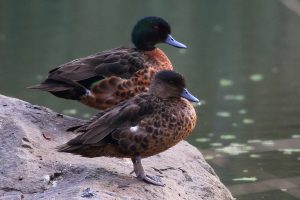 Chestnut Teal: Shy, easily spooked duck that is observed relatively regularly at The Gong Reserve (Buninyong Botanic Gardens), and Buninyong Golf Course. Breeding pairs are endearingly inseparable, and the male in breeding plumage has a very pretty iridescent green head that glistens in the sun. Females look almost identical to Grey Teal (both sexes), but the Chestnut females have warmer tones, and lack white on the throat of Grey Teal. Chestnut Teal: Shy, easily spooked duck that is observed relatively regularly at The Gong Reserve (Buninyong Botanic Gardens), and Buninyong Golf Course. Breeding pairs are endearingly inseparable, and the male in breeding plumage has a very pretty iridescent green head that glistens in the sun. Females look almost identical to Grey Teal (both sexes), but the Chestnut females have warmer tones, and lack white on the throat of Grey Teal. |
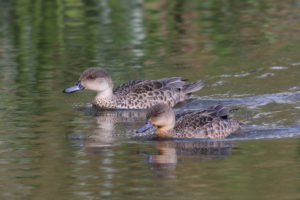 Grey Teal: Confirmed at The Gong Reserve (Buninyong Botanic Gardens), and likely a visitor of Lake Esmond. Smaller than Pacific Black Duck, and similar appearance to the untrained eye, but Grey Teal is smaller, paler, and lacks the black stripes on the head and face. Grey Teal: Confirmed at The Gong Reserve (Buninyong Botanic Gardens), and likely a visitor of Lake Esmond. Smaller than Pacific Black Duck, and similar appearance to the untrained eye, but Grey Teal is smaller, paler, and lacks the black stripes on the head and face. |
 Pacific Black Duck: Common all throughout Ballarat and confirmed in Woowookarung RP. Not picky as to which waterbody it occupies, so it randomly turns up in one of the humble dams throughout Woowookarung RP, and does a flyover passing through the area. Probably the most familiar and recognisable duck. Pacific Black Duck: Common all throughout Ballarat and confirmed in Woowookarung RP. Not picky as to which waterbody it occupies, so it randomly turns up in one of the humble dams throughout Woowookarung RP, and does a flyover passing through the area. Probably the most familiar and recognisable duck. |
 Little Black Cormorant: Confirmed at The Gong Reserve (Buninyong Botanic Gardens), also partial to dams. Has marble-like turquoise eyes. Little Black Cormorant: Confirmed at The Gong Reserve (Buninyong Botanic Gardens), also partial to dams. Has marble-like turquoise eyes. |
 Great Cormorant: Confirmed at Lake Esmond and Buninyong Golf Course. Similar to Little Black Cormorant, only larger and has white and yellow on the cheek. Great Cormorant: Confirmed at Lake Esmond and Buninyong Golf Course. Similar to Little Black Cormorant, only larger and has white and yellow on the cheek. |
 Masked Lapwing: Common all throughout Ballarat but unconfirmed in Woowookarung RP. The common ‘Plover’ as it is colloquially known. Ground-nester that favours open spaces. Masked Lapwing: Common all throughout Ballarat but unconfirmed in Woowookarung RP. The common ‘Plover’ as it is colloquially known. Ground-nester that favours open spaces.
White-winged Triller |
